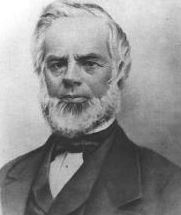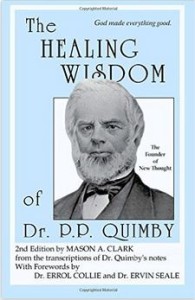Phineas Parkhurst Quimby (1802-1866) was one of the greatest healers ever but nowadays is hardly known. The healings he carried out in New England in the mid-19th Century were little short of miraculous, although he considered them to have a sound scientific basis. Perhaps surprisingly, since so few people have heard of him, his methods and philosophy were well documented at the time and are still available today.
Quimby had already begun to chronicle his ideas and methods before he died, although hampered by poor spelling and grammar which made some of his writings difficult to decipher. Two patients, the Ware sisters, had edited some of his material and made copies to give to other patients, but he was too busy in his practice to publish his writings. He did, though, leave behind copious notes which explained his philosophy and methods in his unique, quirky language. Where suitable terms did not exist, he invented his own, making some passages difficult to understand.
After his death, his youngest son George, who had acted as his secretary, carefully guarded his manuscripts. But – for reasons that will become apparent – he refused to publish them until after the death of his most famous patient, Mrs Mary Baker Eddy, the founder of the Christian Science movement. However, he died before her, so not until 1921 were edited excerpts first published (by Horatio Dresser, son of Julius). Another sixty-eight years passed before The Complete Writings appeared[1], edited by Dr Ervin Seale, who devoted much of his life to this task.
Around 1860, a few of Quimby’s former patients began committing his ideas to paper, determined to spread his ideas to the world.
The first was Rev Warren Felt Evans, a Methodist Minister, who wrote the definitive contemporaneous account of Quimby in his book, ‘The Mental Cure’ (1869). Rev Evans had been in poor health for many years before Quimby cured him completely of a nervous disorder.
One day he confided his belief to Quimby that he could heal using the same methods, and Quimby encouraged him. His first attempts were so successful that he chose to devote the remainder of his life to healing and writing. In 1867, he established a practice in Claremont, New Hampshire, which he ran until his death in 1889.
In his second book, ‘Mental Medicine,’ (1872) he paid tribute to his teacher and friend. He wrote:
‘Disease being in its root a wrong belief, change that belief and we cure the disease. By faith we are thus made whole. There is a law here the world will sometime understand and use in the cure of the diseases that afflict mankind. The late Dr Quimby, one of the most successful healers of this or any age, embraced this view of the nature of disease, and by a long succession of most remarkable cures proved the truth of the theory and the efficiency of that mode of treatment. Had he lived in a remote age or country, the wonderful facts which occurred in his practice would have been deemed either mythical of miraculous.’
Mrs Eddy became a friend, student and patient of Quimby in 1862 after six years as an invalid and depressive. Shortly after her mentor’s passing, she fell badly on ice and suffered a serious injury. She tried to persuade Julius Dresser to treat her, but he refused. Instead, having carefully observed the late Dr Quimby, she applied what she had learned, and by the end of 1866, had made a full recovery. She dated her ‘discovery’ of ‘Christian Science’ (a term previously used by Quimby and the title of a book written by a Rev William Adams in 1850) to that year. The commonalities between her and Quimby’s work are quite apparent, although Mrs Eddy felt it necessary to integrate her Christian faith into Quimby’s ideas since he was so critical of organised religion.
Then she turned on him. Once an avid admirer, she dismissed him as a mere mesmerist (while acknowledging his remarkable powers as a healer) and claimed his discoveries as her own. She claimed she had made them for herself before she even met him.
Her best known work, ‘Science and Health,’ was published in 1875, remains in print, and is widely read to this day. Eddy ‘disciples’ regard it as second in importance only to the Bible. But her refusal to acknowledge Quimby angered some of those with whom she had studied, because they knew that he had developed mental healing years before Mrs Eddy went to him as a patient.
Chief among these were the Dressers. Julius was close to death before regaining his health with Quimby’s help. He became a healer and teacher. His wife Annetta was also cured by Quimby and wrote, ‘The Philosophy of P.P. Quimby’ (1895). Later, Julius and his son Horatio edited Quimby’s writings in detail. Horatio was in no doubt that Mrs Eddy had no knowledge of mental healing prior to their first encounter in 1862 and had borrowed heavily from the writings of Quimby and Evans. ‘It is now easy to see just when and just where she ‘discovered Christian Science,’ he wrote.
A century later, a Quimby scholar, the late Dr Ervin Seale, was more charitable to Mrs Eddy, pointing out that Mrs Eddy’s skills as a self-publicist ensured that Quimby’s ideas lived on. ‘If it had not been for P. P. Quimby,’ wrote Dr Seale, ‘there would have been no Mrs. Eddy, and if it had not been for Mrs. Eddy we should never have known of Quimby.’
Indeed, Mrs Eddy gathered around her a group of influential teachers who travelled the length and breadth of North America spreading her message. One of these was the ‘teacher of teachers’, Mrs Emma Curtis Hopkins. Mrs Hopkins was editor of the Christian Science Journal before being sacked by the dictatorial Mrs Eddy and founding her own school in Chicago. One day in 1886, one of her students, Dr E.B. Weeks, delivered a talk on healing in Kansas City, Missouri. In the audience was a 41 year-old schoolteacher, Myrtle Fillmore, suffering from tuberculosis which her doctors had pronounced terminal.
When she emerged from the hall, inspired by Dr Weeks, one thought repeated itself over and over in her mind: ‘I am a child of God and therefore I do not inherit sickness.’ Her belief that she was fragile crumbled, and after nearly two years of dedicated mental effort she was completely cured. The following year, at the age of 44, she gave birth to for the third time.
Mrs Fillmore wrote an account of her healing[2]. The turning point, she said, was when she realised one day that Intelligence as well as Life is needed to make a body. ‘Life has to be guided by Intelligence in making all forms, whether a worm or a human being. Life is simply a form of energy, and has to be guided and directed in man’s body by his intelligence. How do we communicate with Intelligence? By thinking and talking, of course!’ With this realisation, she became attentive to her thoughts and prayed every hour for help from Spirit. She asked for forgiveness for past mistakes and told her muscles and organs that they were drawing on an unlimited Source and were healthy and strong.
After the healing, others asked her for help. She helped a crippled man to walk, cured a woman’s asthma, helped a boy blinded by cataracts to see, cured a boy of tonsillitis and another of croup. She told all who sought her help that it was God’s will that they be healthy and that the healing power of Spirit was within them. She later wrote a book based on her experiences, How to Let God Help You.
Meanwhile, her husband, Charles – like Quimby, a sceptical man with a scientific frame of mind – set about discovering the reason for his wife’s recovery. He came to the reluctant conclusion that there was incontrovertible evidence of a Great Power behind the healings that was somehow capable of being directed by human thought.
Charles and Myrtle applied what they learned and went on to found a prayer and healing ministry, Unity, which continues to this day. She died in 1931, aged 86. Charles lived to be 94.
Myrtle Fillmore, a simple, trusting soul, would have had no idea that in recognising that both life (energy) and intelligence (information) had a role in regulating the body she had anticipated science by more than a century, and that some of the most learned brains on the planet would one day validate her experience.
[1] Dr Ervin Seale (Ed.), Quimby Complete Writings, Vols 1-3, De Vorss and Co., 1989
[2] How I Found Healing, pamphlet published by Unity, Kansas City, Missouri
©Feelinggoodallthetime 29.3.2017

Follow us on Facebook and Twitter @Feelinggoodatt

How to Books, 2007





